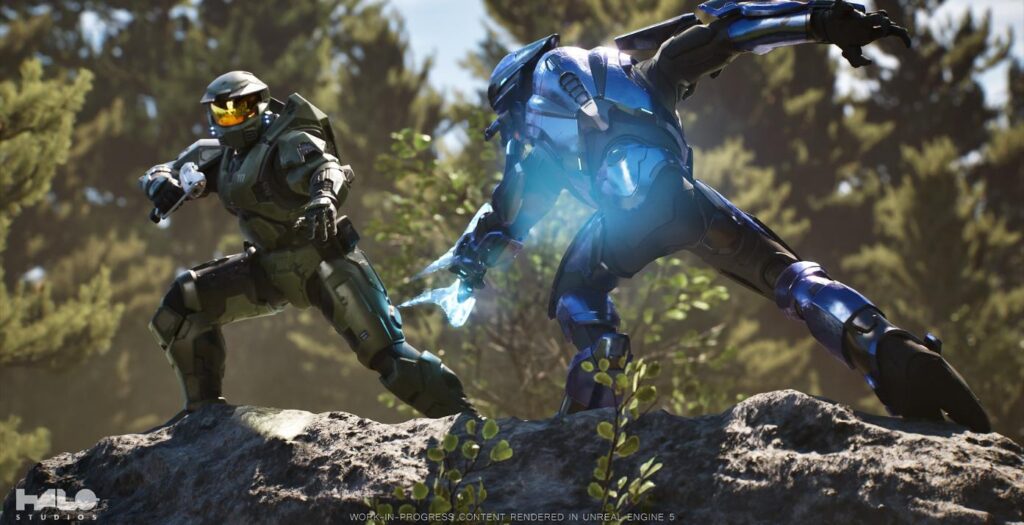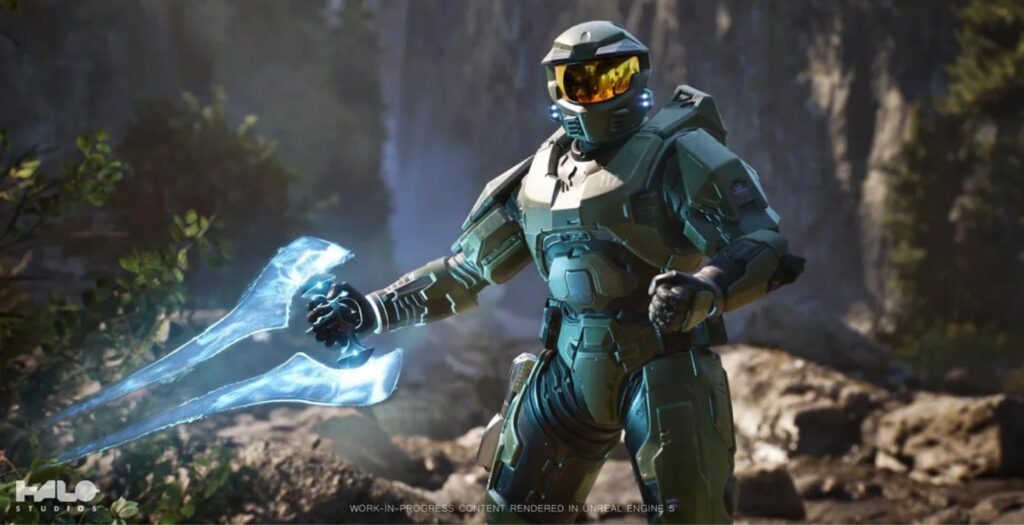At the final day of the Halo World Championships on October 6, Halo fans got some big news. Not only has the series shepherding studio 343 Industries rebranded to Halo Studios, but it was announced that they franchise’s future will be moving from the in-house Slipspace Engine to Unreal Engine 5.
The news was announced with a YouTube trailer highlighting some tests the studio worked on with the engine through what it dubbed Project Foundry. It is no secret that Halo has been struggling as a series since Halo Studios first took it over, and this new push is being positioned as an effort to inspire confidence in the fans who have grown more and more disappointed over the years. I am one of those fans through and through, but, unfortunately, what Xbox Studios has shown to try and win me over has only left me feeling more concerned.
A Brief History of Halo

Before looking at the series’ future, which Halo Studios talked about, we need to understand where the series is at present and how it got here. Do not worry. I’ll try to get through the series’ decades-long history with some brevity. Halo premiered with the release of Halo: Combat Evolved in 2001, developed by Bungie and published by Xbox after its acquisition of the developer. It was released as a launch title for the original Xbox console and revolutionized the first-person shooter genre that had struggled to find a comfortable foothold away from the PC. Combat Evolved was a massive success for Bungie and Xbox, and the pair ended up releasing the likes of Halo 2, Halo 3, and Halo: Reach in the following years.
In 2007 it was announced that Bungie was splitting away from Xbox to become its own company. The studio still released the standalone expansion Halo 3: ODST and Halo: Reach in the years that followed through a partnership with Xbox. The split led to the creation of Halo Studios (then known as 343 Industries), a first-party developer constructed from the ground up to take over Halo, which had now become a flagship title for Xbox.
The studio took complete control over the franchise, overseeing the release of tie-in media such as the Paramount+ show Halo, spin-off video game titles that experimented with new genres like Halo Wars and Halo: Spartan Assault, and developing their own trilogy of mainline games.

Halo Studios’ mainline trilogy is comprised of Halo 4 (2012), Halo 5: Guardians (2015), and Halo Infinite (2021). Each of Halo Studios’ mainline entries have really excelled at the mechanics. The studio has managed to modernize and iterate on the feel of playing as the sci-fi super soldier Spartans at the core of the series’ identity. With each entry Halo Studios has widened the pool of tools at player’s disposal to great success, with Halo Infinite taking the crown as my favorite multiplayer Halo experience to date.
It is elsewhere that the studio has struggled. Their trilogy of titles has been plagued by releases missing key features at launch, lackluster campaigns so steeped in the series’ lore and books that the wiki is almost necessary to fully understand them, and post-release support marred by slow updates and frustrating monetization. These issues hit Halo Infinite particularly hard, which was followed by numerous high-profile leadership position shake-ups.
This is where Halo sits now. Halo Infinite‘s reportedly planned story expansions have been canceled, its live service post-release structure was largely diminished a little under two years after release, and fans had been waiting to see what comes next before Halo Studios’ recent announcement.
Halo Studios’ Pitch for Halo’s Future

The Project Foundry video showcases three environments the team at Halo Studios made in Unreal Engine 5. The first is very familiar to fans, and is based on the pacific northwest, accompanied by a diorama of Master Chief fending off two elites. Then there is a misty tundra of dazzling ice that seems to glow with deep blue-green energy. And finally, is a region completely corrupted by the terrifying organic presence of the Flood, resembling a sprawling field of undulating flesh and strange growths.
Each of the three scenes is undeniably beautiful. They are packed with details from the incredible depth of foliage to the individual pads of Master Chief‘s gloves and the metallic stamping of his trusty Magnum. All three scenes manage to capture the imagination despite the sparse showings each receives. And alongside all of that beauty members of the Halo Studios team talk about shifting the studio’s approaches and axioms regarding development alongside the jump to Unreal Engine 5. They even reveal that the studio is currently in the early stages of development for multiple new titles, marking a clear starting flag for the fanbase’s hype train after being reinvigorated by the video.
I’ll be the first to admit that a lot of that sounds great. I have spent hours preaching to anyone who will listen to how underutilized the Halo IP is with its slow output of largely sequential titles. And I applaud the studio’s leadership making the difficult decision to cut the sunk costs of the Slipspace Engine, which it now admits caused issues and delays in development. All around these seem like great early moves for Halo’s future as a series.
What concerns me with the video is its focus on graphics. During the video Daniel Henley, the lead fx artist of Halo Studios, remarks that early games in the series were “graphical showcases” and that that is what the future of Halo needs to be. From that point on the video focuses on giving specific details of those great graphics and just how beautiful the studio’s future games will be.
Focusing on the graphics of upcoming Halo games as the rallying call for the series is quite worrying. Apart from the Craig meme preceding the release of Halo Infinite, graphics have never been an issue for the series. The problems fans have had with Halo Studios’ shepherding of the franchise cannot be summarized as people saying the titles are ugly.

A focus on the games being beautiful will likely hold negative consequences for Halo Studios as well. Chasing high-fidelity graphics consumes a lot of resources and, perhaps most importantly of all, takes a lot more time for developers. AAA series throughout the industry have seen their development time balloon far beyond what was necessary for their predecessors.
This means fewer releases, higher budgets, and more of the development’s resources being dedicated solely to how the game looks. I would much rather have those resources used to fund other aspects of the titles, like avoiding crunch time for developers near launch, releasing feature-complete, or spending more time developing and iterating on interesting mechanics and gameplay loops.
If Halo Studios really wanted this video to inspire faith in the studio from fans it should have actually addressed the complaints that have actually been levied against the studio. Issues like the lack of features at titles at launch or how the studio keeps eschewing split-screen co-0p despite the fanbase’s clear desire for it.
Or the series’ problems with monetization through Halo 5‘s exploitative loot box REQ system or the incredibly expensive and restrictive customization options in Halo: Infinite. Or how consistently the studio has struggled to produce a story campaign that nears the quality of the original titles under Bungie. Those are the issues with the franchise that I, as a lifelong Halo fan, am most interested in hearing Halo Studios address, especially if they want me to get excited about the series’ future.
I still have hope for Halo’s future. Some of the smaller details in the video, paired with a shake-up in leadership, do make it feel like Halo is headed for a new era. However, I do have concerns about Halo Studios’ focus moving into that era being as surface level as this new video implies. It is good to see Halo Studios starting to address the issues from its past, but if it stops switching engines, its other historical issues will remain unresolved. But if those issues can be resolved, the future of Halo could be as beautiful as the vistas they showcased.







